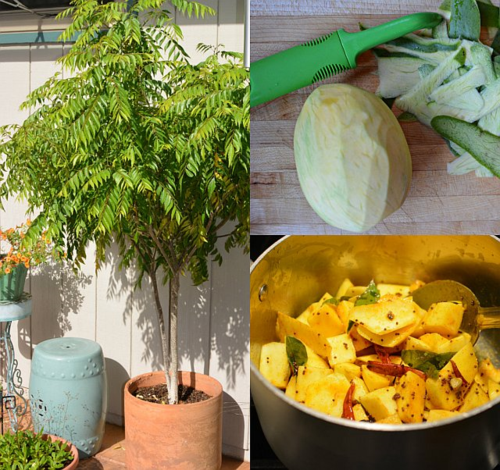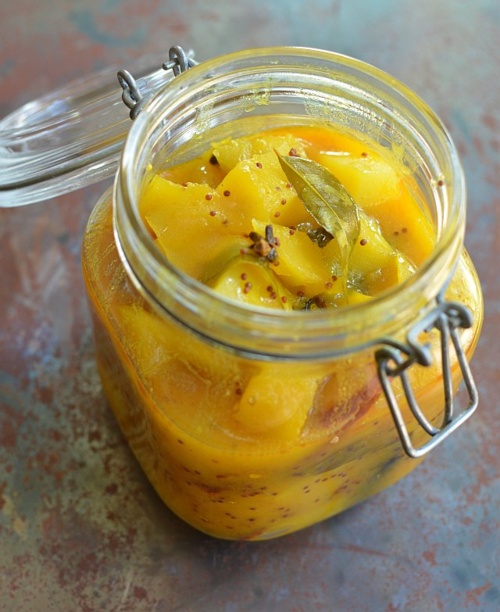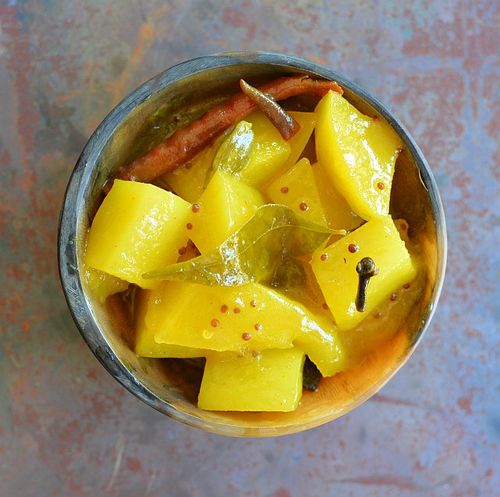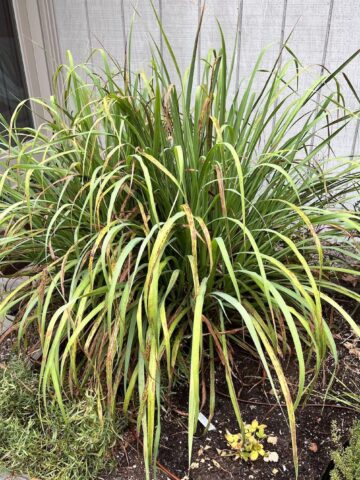Last Saturday, after teaching all day, I was dead tired but I was bent on making this Indian mango pickle. I’d purchased the two green (unripe) mangoes at an Asian market on Thursday and feared them ripening sooner than later. Mango can ripen quickly and you can’t really tell by the green skin and hard texture. Something is happening inside.
I had to do something with them, lest I waste the relatively rare specimens. Unless you’re in tropical Asia or other mango-laden area where there maybe a nearby mango tree or mango vendor, rock hard, green mangoes are hard to find. In the U.S., we mostly want ones that are on their way to sweet, soft ripeness. At Asian markets, green mangoes usually cost more than ripe ones. On Thursday, the cashier and I laughed about the premium paid for unripe, sour fruit.
My goal was to make a mango pickle from Saveur magazine’s India issue. I tried the Kashmiri lamb with chile sauce and that was a hit. How would this simple, quick pickle turn out? Cookbook author Smita Chandra wrote lovingly about her mother’s homemade pickles and that reminded me of my mom’s pickling prowess. I was smitten, especially with the use of cinnamon/cassia, cloves, cardamom and other spices.
Around 9pm, I made the pickle, simmering it longer than specified in the original recipe to render the unripe mango tender and then I left the pickle to cool overnight. The next day, it was fabulous tasting with a balance of heat, pungency, and tang. The oil and spices gave the pickle a plush richness. I ate a chunk at breakfast on Sunday and wondered how it would taste with grilled or roasted chicken or pork. Its medium-soft texture was somewhat like a chutney more than a chewy-soft pickle. I wondered why.

When I went to write this post, I realized that I’d made it wrong. I misread the recipe and peeled the mangoes. Southeast Asian mango recipes mostly call for peeling the fruit, e.g., you don’t know how the fruit was grown, transported, and stored. I assumed that approach was the same for the Indian mango pickle.
I looked up other green mango pickles recipes in Pushpesh Pant’s massive India: The Cookbook. Low and behold, the fruit is typically left unpeeled for pickles. I imagine that that not only lends texture but also a certain level of astringency. Chandra’s article, “Preserving Culture”, was cut short and there was obviously not enough room to explain some of these finer points to cooks. I wish there had been because I’m sort of guessing here as to why the peel is left on the fruit. (See the original mango pickle recipe (aamba khatta) here.)

In any event, the pickle is good tasting. I don’t consider this a disaster as it’s more of a lesson on why you shouldn’t try a new recipe when you’re tired! My mistake opens options: You can keep the peel on or off. I’d wash and gently scrub the mango if I were keeping the peel.
A note on curry leaves: I grow it and have a ton right now. It’s a fragrant leaf used in South and some Southeast Asian cooking. You can buy it at Indian and other Asian markets that may cater to Indian customers. I don’t recommend using dried curry leaf. You could omit it, or maybe substitute 1 teaspoon fenugreek, nigella (kalonji) or cumin seed; the former two are sold at Indian markets and well-stocked grocers. I also had a crazy thought of substitute a 2-inch sprig of rosemary to mimic the slightly petroleum quality of curry leaf.
RECIPE
Quick Green Mango Pickle
Aamba Khatta
Yields: 3 cups
Ingredients
- 2 green, unripe mangoes, unpeeled, pitted, quartered, and sliced 1" thick
- 1 teaspoon ground turmeric
- ½ teaspoon red chile powder, such as cayenne
- ¼ cup canola oil
- 2 teaspoons brown or black mustard seeds
- 1½ teaspoons green cardamom pods
- ½ teaspoon whole cloves
- 12 fresh or frozen curry leaves
- 5 dried chiles de árbol, stemmed
- 1 stick cassia or cinnamon, broken into 2 pieces
- ½ cup sugar
- 1 ½ teaspoons sea salt salt or 1 tablespoon kosher salt
- 1 ¼ cups water
Method
1. Prep the mango. Peel it with a vegetable peeler or wash and scrub the skin if you’re keeping the skin on. Cut the mango into thick cheeks, removing as much flesh as you can from the pit. Discard the pit. Do your best to cut the mango into 1-inch chunks. Transfer to a bowl and dump in the turmeric and chile powder. Set the stove.
2. Put the oil in a 4 quart (1 L) saucepan. Turn the burner to medium-high heat, then add the mustard seeds, cardamom, cloves, curry leaves, chiles, and cinnamon. Cook, stirring occasionally until the seeds pop, 1 to 2 minutes.
3. Add the mango. Stir to combine well. If you peeled the mango, cook for 2 to 3 minutes to develop the flavor, before adding the sugar, salt, and water. If you did not peel the mango, follow the original recipe instructions by cooking the fruit for 8 to 10 minutes until tender before adding the sugar, salt and water.
4. Let the mango summer 8 to 10 minutes if you peeled the fruit. Or, 2 to 3 minutes if you kept the peel on. Turn off the heat and leave uncovered to cool completely and concentrate in flavor. Use or transfer to an airtight container. Store in the refrigerate and return to room temperature before eating.
Adapted from Smita Chandra’s story, “Preserving Culture”, in the August/September 2014 special India issue of Saveur magazine.
Related posts:


















Kat says
Just wondering why you do not recommend dried curry leaves?
I grow it and dry it and love the smell and taste on a lot of dishes. Also I have the biggest Mango tree you can imagine. Over 200 unripe mangos blew off yesterday during the tropical storm watch for Alberta. The tree is still full, unfortunately I seem to be allergic to tree bark, swing, leaves and fruit.
So it is not my favorite tree at all. I was trying to figure out how to send you a pick of both tree and the huge pile of blown off cracked and split mangos that blew off, but the black snakes, birds,and squirrels and other wildlife love them.
Andrea Nguyen says
The dried curry leaves that I've come across commercially in America are not very good. You sound like you're in a blessed part of the world. If anything, I freeze curry leaves. I grow curry leaves too and they're super hardy.
Mangos-- wow. I'm sorry you lost so many fruits! That's a lot of green mango on hand. Yikes! Take care, Kat!